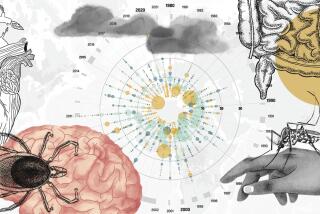‘EPIDEMIC’ DISEASE
- Share via
What makes a disease epidemic? The very definition implies panic.
There is no set number of victims. Between the years 1347 and 1351 bubonic plague killed as many as 75 million people in Europe; legionnaire’s disease took only 29 lives when it struck Philadelphia in the summer of 1976. Yet both were considered epidemics.
Malaria, on the other hand, continues to strike nearly 100 million people every year, yet it is not now considered an epidemic. Rather, it is said to be endemic to certain regions of the world.
A disease, like malaria, is endemic--but not necessarily epidemic--when it is common to a region, as in the tropics. But the same disease becomes epidemic when it affects a much greater number of people than is usual for the locality or when it spreads to regions where it is normally not present.
Although the term epidemic is popularly used for all sudden and unexplained outbreaks of disease, technically they become pandemics when they spread to several countries.
In a sense, when enough people--including doctors or medicine men--begin to panic over the occurrence of a disease, it has reached epidemic or pandemic proportions.






